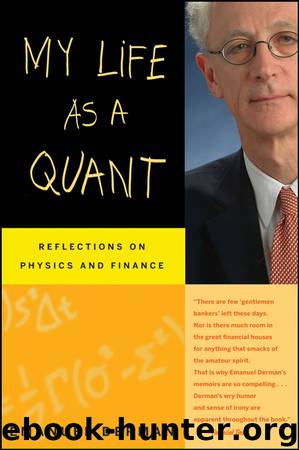My Life as a Quant by Emanuel Derman

Author:Emanuel Derman
Language: eng
Format: epub
Publisher: Wiley
Published: 2012-05-21T16:00:00+00:00
Chapter 10
Easy Travel to Other Planets
The history of options theory
Meeting and working with Fischer Black
The Black-Derman-Toy model
Wall Street had never been a place for academics. Yet, from the day I got to Goldman in late 1985, I kept hearing people talk with awe about Fischer Black, codiscoverer of the Black-Scholes equation for options pricing and the head of Goldman’s Quantitative Strategies group. I saw him once at a meeting in the first few months after I arrived, but never spoke to him until the traders on the bond options desk arranged for us to meet.
Some traders are scornful of models; others will rely on them blindly. Our bond options traders knew that you need to layer visceral trading smarts over and above a consistent options pricing model. They understood they needed something beyond Ravi’s original model, and so they approached Fischer about taking the next step. Since I had earned some credit for having diagnosed and then eliminated one small but glaring inconsistency in Ravi’s model soon after I arrived, they therefore suggested that I join Fischer in an effort to build a better model.
Before I went up to his office on the twenty-ninth floor to meet him, to show him what I had done so far, and, implicitly, to see if he would have me work with him, I read a little more on the history of options theory.
Until the early 1970s, no one knew how to estimate the value of options in a convincing way. A call option that paid off when the stock price rose seemed much like a bet on a horse: The more optimistic you were about the stock’s future prospects, the more you should be willing to pay for it. Each person set his own fair price.
Then, in 1973, Fischer Black and Myron Scholes published their eponymous Black-Scholes equation for the value of an option. That same year, Robert Merton provided a more rigorous and insightful way of understanding the argument behind their equation. Eventually, his formalism came to supplant theirs, and became the standard. Merton and Scholes won the 1997 Nobel Prize in Economics for their work, but Fischer, who was certainly their equal, died in 1995. Had he been fortunate enough to have lived a couple of years longer, he would surely have been a corecipient of the Prize.
I used to find it almost impossible to understand why the Nobel committee didn’t award the Prize for options theory before Fischer died. Everyone in the finance community knew that it was only a matter of time before Black, Scholes, and Merton would receive the award, and it had also been common knowledge for several years that Black was mortally ill with throat cancer. I’ve heard speculations that the Nobel committee was reluctant to give the award to someone who worked in the business world, especially in the profitable and untheoretical business of investment banking.
Fischer, who had a PhD in Applied Mathematics from Harvard, had been a management consultant at Arthur D. Little and Co.
Download
This site does not store any files on its server. We only index and link to content provided by other sites. Please contact the content providers to delete copyright contents if any and email us, we'll remove relevant links or contents immediately.
The Complete Stick Figure Physics Tutorials by Allen Sarah(7133)
Secrets of Antigravity Propulsion: Tesla, UFOs, and Classified Aerospace Technology by Ph.D. Paul A. Laviolette(4971)
Thing Explainer by Randall Munroe(3781)
The River of Consciousness by Oliver Sacks(3408)
The Order of Time by Carlo Rovelli(3070)
How To by Randall Munroe(2911)
I Live in the Future & Here's How It Works by Nick Bilton(2837)
A Brief History of Time by Stephen Hawking(2816)
What If?: Serious Scientific Answers to Absurd Hypothetical Questions by Randall Munroe(2542)
The Great Unknown by Marcus du Sautoy(2531)
Midnight in Chernobyl by Adam Higginbotham(2380)
Blockchain: Ultimate Step By Step Guide To Understanding Blockchain Technology, Bitcoin Creation, and the future of Money (Novice to Expert) by Keizer Söze(2377)
Networks: An Introduction by Newman Mark(2264)
The Meaning of it All by Richard Feynman(2211)
Easy Electronics by Charles Platt(2204)
The Tao of Physics by Fritjof Capra(2161)
Midnight in Chernobyl: The Untold Story of the World's Greatest Nuclear Disaster by Adam Higginbotham(2070)
When by Daniel H Pink(2019)
Introducing Relativity by Bruce Bassett(2014)
